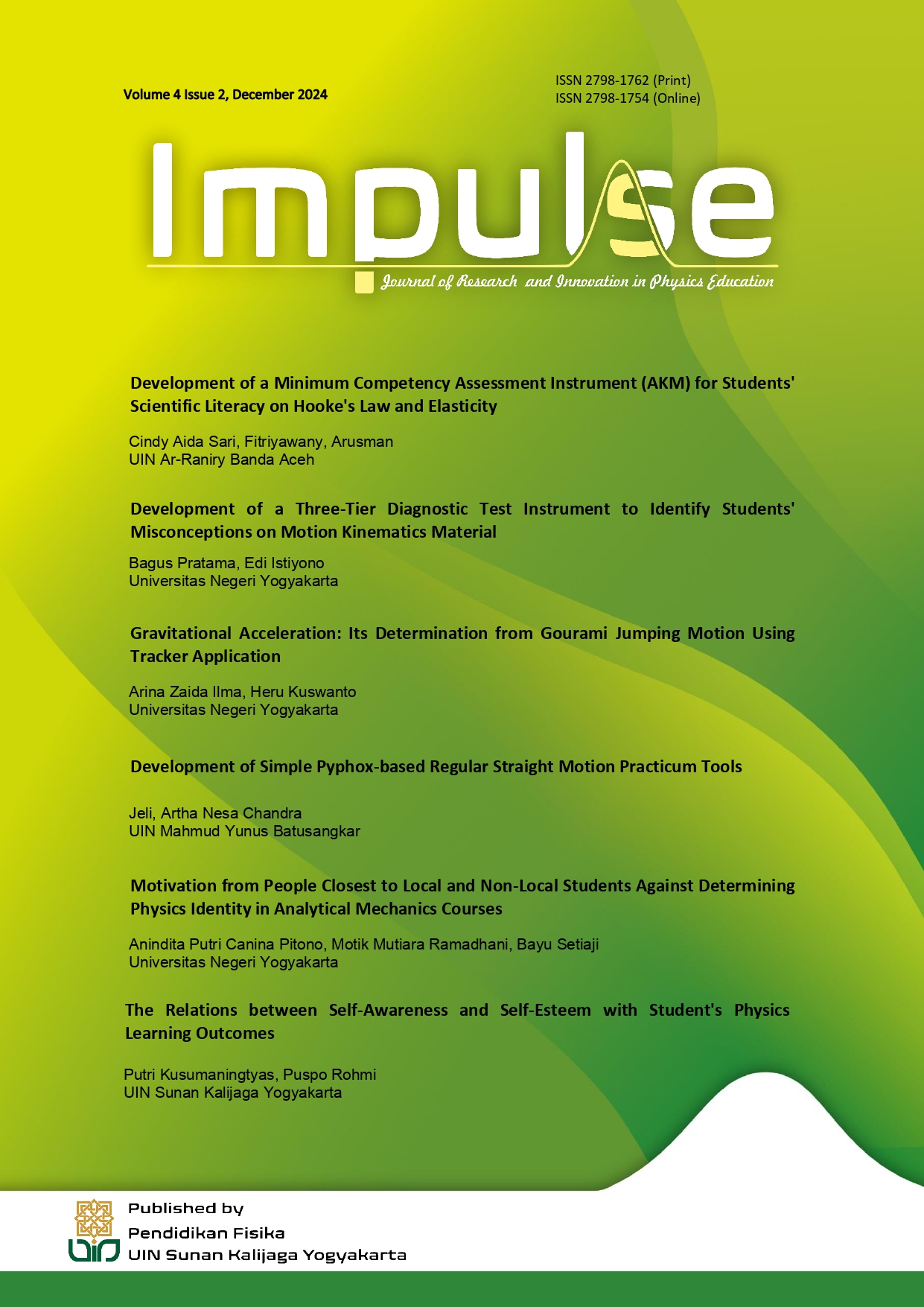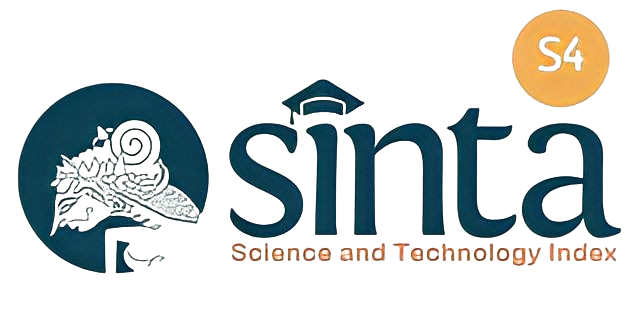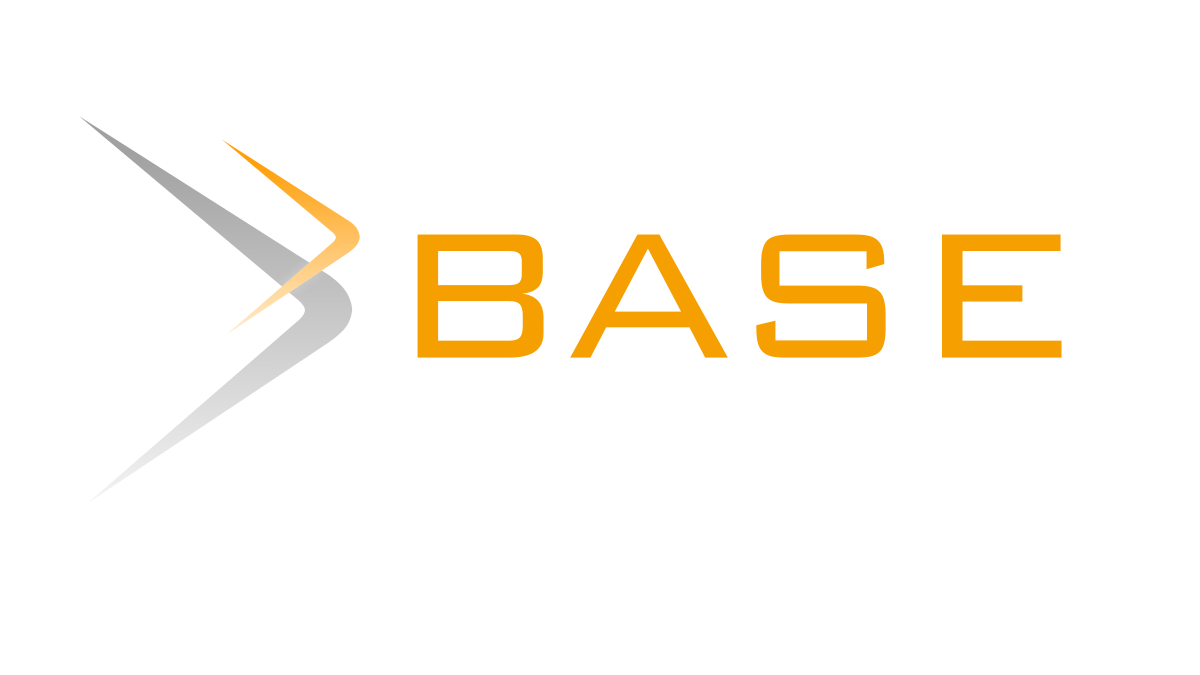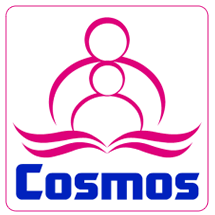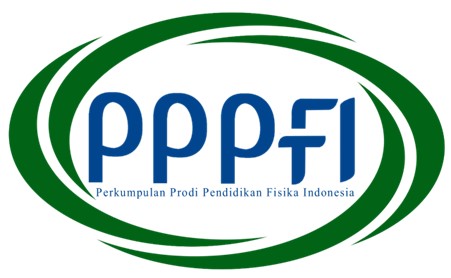Gravitational Acceleration: Its Determination from Gourami Jumping Motion Using Tracker Application
DOI:
https://doi.org/10.14421/impulse.2024.42-03Keywords:
Gourami fish, Gravitational acceleration, Jumping motion, Tracker applicationAbstract
Jumping out of the water is one of the phenomena of aquatic animals. Analyzing the motions and routines of aquatic animals is a time-consuming process and tends to be subjective, prone to errors due to observer fatigue. In investigating the motion of objects is a difficult thought, but with the development of technology it becomes easy, one of them is by using the Tracker. This research aims to analyze the Gourami jumping motion using the Tracker in independent experiment activities about animal motion. The materials and tools needed include Gourami fish, Android camera, and Tracker application. The measurement results are the data on time, position, and the graph of motion. Gourami jumping motion is a parabolic motion consisting of uniform linear motion on the x-axis, while uniformly accelerated linear motion on the y-axis. The value of the gravitational acceleration can be determined from the graph and its value is close to the gravitational acceleration constant. The use of video analysis of the Gourami motion using the Tracker can be used in science learning, especially in physics experiment.
Downloads
References
W. Widodo, D. A. P. Sari, T. Suyanto, M. Martini, and I. Inzanah, “Pengembangan keterampilan pemodelan matematis bagi calon guru IPA,” J. Inov. Pendidik. IPA, vol. 6, no. 2, pp. 146–155, 2020, doi: 10.21831/jipi.v6i2.27042.
N. A. Campbell, L. A. Urry, M. L. Cain, S. A. Wasserman, P. V. Minorsky, and J. B. Reece, Biology A Global Approach, Eleventh E. United States of America: Pearson Education, 2018.
C. Eloy, “Optimal Strouhal number for swimming animals,” J. Fluids Struct., vol. 30, pp. 205–218, 2012, doi: 10.1016/j.jfluidstructs.2012.02.008.
A. Klein, “The curious case of the decapitated frog: on experiment and philosophy,” Br. J. Hist. Philos., vol. 26, no. 5, pp. 890–917, 2018, doi: 10.1080/09608788.2017.1378866.
B. Chang, J. Myeong, E. Virot, C. Clanet, H. Y. Kim, and S. Jung, “Jumping dynamics of aquatic animals,” J. R. Soc. Interface, vol. 16, no. 152, 2019, doi: 10.1098/rsif.2019.0014.
B. J. Vetter, A. F. Casper, and A. F. Mensinger, “Characterization and management implications of silver carp (Hypophthalmichthys molitrix) jumping behavior in response to motorized watercraft,” Manag. Biol. Invasions, vol. 8, no. 1, pp. 113–124, 2017, doi: 10.3391/mbi.2017.8.1.11.
G. R. Parsons, E. Stell, and J. J. Hoover, “Estimating burst swim speeds and jumping characteristics of silver carp (Hypophthalmichthys molitrix) using video analyses and principles of projectile physics,” Report, no. October 2016, 2016.
H. K. Preisler, A. A. Ager, and M. J. Wisdom, “Analyzing animal movement patterns using potential functions,” Ecosphere, vol. 4, no. 3, pp. 1–13, 2013, doi: 10.1890/ES12-00286.1.
Z. Tablado and L. Jenni, “Determinants of uncertainty in wildlife responses to human disturbance,” Biol. Rev., vol. 92, no. 1, pp. 216–233, 2017, doi: 10.1111/brv.12224.
M. R. Baker, K. S. Gobush, and C. H. Vynne, “Review of factors influencing stress hormones in fish and wildlife,” J. Nat. Conserv., vol. 21, no. 5, pp. 309–318, 2013, doi: 10.1016/j.jnc.2013.03.003.
P. Rachinas-Lopes, R. Ribeiro, M. E. Dos Santos, and R. M. Costa, “D-Track—A semi-automatic 3D video-tracking technique to analyse movements and routines of aquatic animals with application to captive dolphins,” PLoS One, vol. 13, no. 8, pp. 1–12, 2018, doi: 10.1371/journal.pone.0201614.
T. Fukunaga, S. Kubota, S. Oda, and W. Iwasaki, “GroupTracker: Video tracking system for multiple animals under severe occlusion,” Comput. Biol. Chem., vol. 57, pp. 39–45, 2015, doi: 10.1016/j.compbiolchem.2015.02.006.
A. Pérez-Escudero, J. Vicente-Page, R. C. Hinz, S. Arganda, and G. G. De Polavieja, “IdTracker: Tracking individuals in a group by automatic identification of unmarked animals,” Nat. Methods, vol. 11, no. 7, pp. 743–748, 2014, doi: 10.1038/nmeth.2994.
A. Rossouw, M. Hacker, and M. J. De Vries, “Concepts and contexts in engineering and technology education: An international and interdisciplinary delphi study,” Int. J. Technol. Des. Educ., vol. 21, no. 4, pp. 409–424, 2011, doi: 10.1007/s10798-010-9129-1.
L. K. Wee and T. K. Leong, “Video Analysis and Modeling Performance Task to Promote Becoming Like Scientists in Classrooms,” Am. J. Educ. Res., vol. 3, no. 2, pp. 197–207, 2015, doi: 10.12691/education-3-2-13.
D. H. Nichols, Physics for Technology, Second Edi. Boca Raton: Taylor & Francis Group, 2019.
P. Hockicko, “Forming of physical knowledge in engineering education with the aim to make physics more attractive,” in Physics Teaching in Engineering Education (PTEE), 2011, pp. 1–5.
E. Yusuf, “Using tracker to engage students’ learning and research in physics,” Pertanika J. Sci. Technol., vol. 24, no. 2, pp. 483–491, 2016.
A. Anissofira, F. Dzar, and E. Latief, “Analisis Gerak Roller Coaster Menggunakan Tracker dengan Pendekatan Multi Modus Representasi Sebagai Sarana Siswa Memahami Konsep Kinematika,” Pros. SKF 2016, pp. 26–32, 2016.
O. Mirat, J. R. Sternberg, K. E. Severi, and C. Wyart, “ZebraZoom: An automated program for high-throughput behavioral analysis and categorization,” Front. Neural Circuits, vol. 7, no. June, pp. 1–12, 2013, doi: 10.3389/fncir.2013.00107.
A. Z. Ilma, H. Kuswanto, and A. Hujatulatif, “Jumping Motion of Gourami Fish Using Tracker Software as a Mechanical Energy Conservation Practicum,” J. Penelit. Pendidik. IPA, vol. 8, no. 5, pp. 2154–2158, 2022, doi: 10.29303/jppipa.v8i5.2071.
D. Ramadhanti, H. Kuswanto, H. Hestiana, and A. Azalia, “Penggunaan Analisis Video Gerak Kucing Melompat Berbantuan Aplikasi Tracker Sebagai Kegiatan Praktikum Mandiri Materi Gerak pada Peserta Didik SMP,” J. Pendidik. Sains Indones., vol. 9, no. 3, pp. 459–470, 2021, doi: 10.24815/jpsi.v9i3.20547.
S. Ballesta, G. Reymond, M. Pozzobon, and J. R. Duhamel, “A real-time 3D video tracking system for monitoring primate groups,” J. Neurosci. Methods, vol. 234, pp. 147–152, 2014, doi: 10.1016/j.jneumeth.2014.05.022.
F. De Chaumont et al., “Computerized video analysis of social interactions in mice,” Nat. Methods, vol. 9, no. 4, pp. 410–417, 2012, doi: 10.1038/nmeth.1924.
L. K. Kanga, R. B. Astro, Y. E. Ika, P. Education, and S. Program, “Analysis of Vertical Movements on Freedom and Bullet,” vol. 4, no. 1, pp. 19–25, 2021.
A. H. Setyadin et al., “Optimalisasi Bandul Matematis Menggunakan Tracker dalam Penentuan Perubahan Percepatan Gravitasi Permukaan Bumi (G) Akibat Gerhana Matahari Sebagian (GMS) 9 Maret 2016,” in Seminar Nasional Fisika, 2016, pp. 167–170. doi: 10.21009/0305020132.
D. P. Sari, W. Widodo, and Madlazim, “Sciences Practicum in The Covid-19 Pandemic Era by Using a Video Tracker,” J. Inov. Pendidik. dan Sains, vol. 2, no. 3, pp. 75–81, 2021.
R. B. Islami, L. A. Didik, and B. Bahtiar, “Determine of the nira water viscosity by using video based laboratory falling ball method with tracker software,” Gravity J. Ilm. Penelit. dan Pembelajaran Fis., vol. 7, no. 2, pp. 8–20, 2021, doi: 10.30870/gravity.v7i2.10165.
I. Diamond, Science Education in school, TLRP Institute of Education. London: University of London, 2011.
W. F. McComas, Nature of Science in Science Instruction. Switzerland: Springer Nature Switzerland AG, 2020.
F. Mufit, “The study of misconceptions on motion’s concept and remediate using real experiment video analysis,” Asean Comp. Educ. Res. Netw. Conf., pp. 1–7, 2018.
D. Halliday, R. Resnick, and J. Walker, Fundamental of Physics, 9th Editio. New Jersey: John Wiley & Sons Inc, 2011.
R. . Serway and J. Jewett, Physics for Scientists and Engineers with Modern Physics, Ninth Edit. United Stated of America: Books/Cole, 2014.
Giancoli and C. Douglas, Physics Principles with Application, Sixth Edit. New Jersey: Upper Saddle River, 2005.
J. Halliday, D., Resnick, R., Walker, Fundamentals of Physics, 9th Editio. New Jersey: John Wiley & Sons, Inc, 2011.
T. S. Tuhusula, B. Pattana, E. Randai, D. . Wateriri, and A. . Walukow, “Experiments Usingbased Virtual Lab Phet Simulation in Learning Physics on Parabolic Movement Materials,” J. Pendidik. fIS, vol. 9, no. 2, pp. 128–135, 2020.
M. G. Nugraha, K. H. Kirana, F. Nugraha, E. A. Nurinsani, and F. N. Sholihat, “Optimization of Rectilinear Motion Experiments using Tracker Application,” IOP Conf. Ser. Mater. Sci. Eng., vol. 288, no. 1, 2018, doi: 10.1088/1757-899X/288/1/012096.
M. Anni, “Quantitative comparison between the smartphone based experiments for the gravity acceleration measurement at home,” Educ. Sci., vol. 11, no. 9, pp. 1–20, 2021, doi: 10.3390/educsci11090493.
P. Parmin, E. N. Savitri, and Y. N. Ifriza, “Scientific work independence application for various education levels referring to Piaget’s theory to support the implementation of science integrated learning model,” J. Penelit. dan Pembelajaran IPA, vol. 8, no. 2, pp. 175–191, 2022, doi: 10.30870/jppi.v8i2.17442.
Downloads
Published
How to Cite
Issue
Section
License
Copyright (c) 2025 Impulse: Journal of Research and Innovation in Physics Education

This work is licensed under a Creative Commons Attribution-NonCommercial 4.0 International License.

